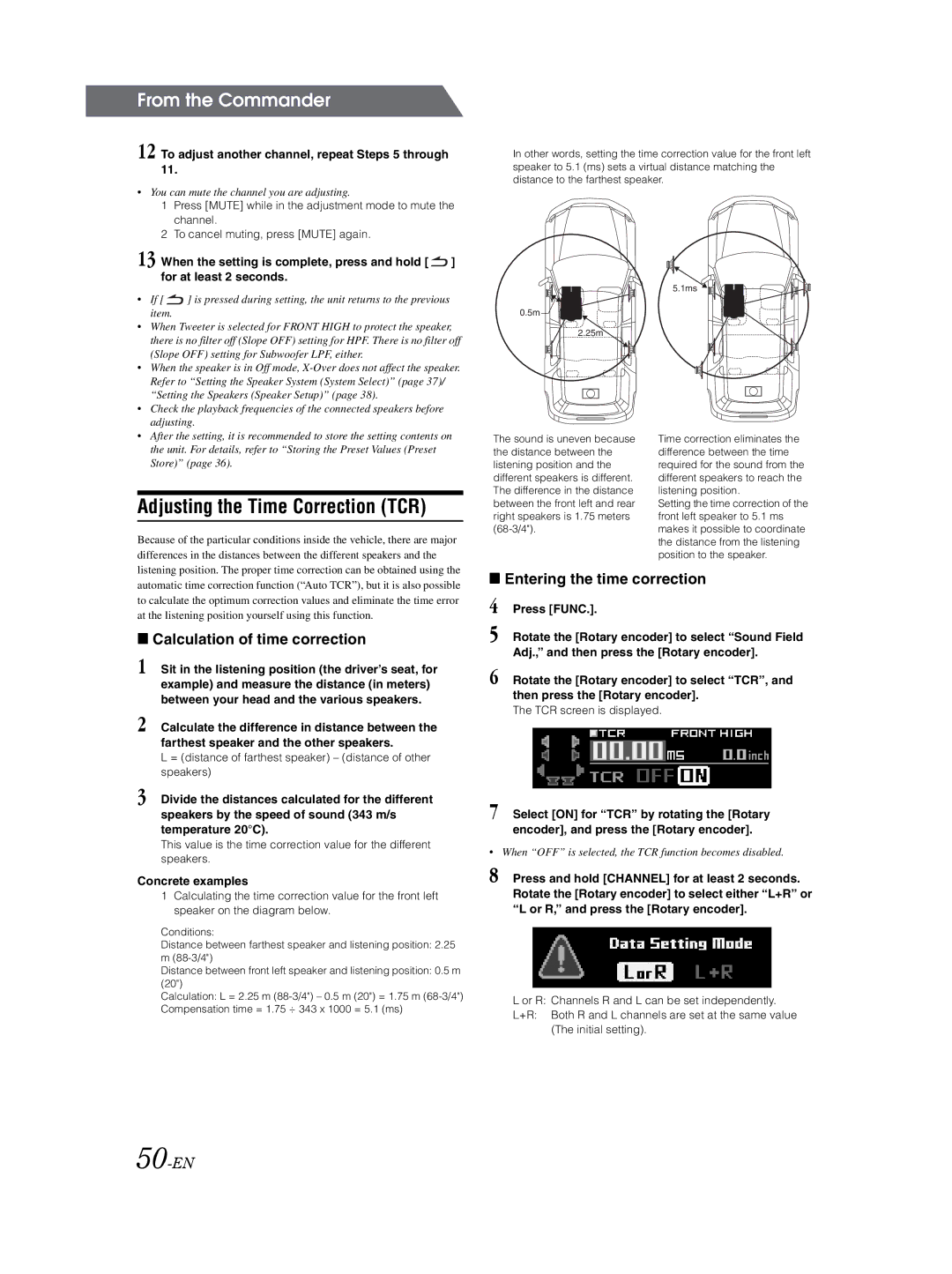
From the Commander
12 To adjust another channel, repeat Steps 5 through
11.
•You can mute the channel you are adjusting.
1Press [MUTE] while in the adjustment mode to mute the channel.
2To cancel muting, press [MUTE] again.
13 When the setting is complete, press and hold [ ![]() ] for at least 2 seconds.
] for at least 2 seconds.
In other words, setting the time correction value for the front left speaker to 5.1 (ms) sets a virtual distance matching the distance to the farthest speaker.
• | If [ | ] is pressed during setting, the unit returns to the previous |
| item. |
|
• | When Tweeter is selected for FRONT HIGH to protect the speaker, | |
0.5m![]()
5.1ms ![]()
![]()
![]()
2.25m
there is no filter off (Slope OFF) setting for HPF. There is no filter off |
(Slope OFF) setting for Subwoofer LPF, either. |
• When the speaker is in Off mode, |
Refer to “Setting the Speaker System (System Select)” (page 37)/ |
“Setting the Speakers (Speaker Setup)” (page 38). |
• Check the playback frequencies of the connected speakers before |
adjusting. |
• After the setting, it is recommended to store the setting contents on |
the unit. For details, refer to “Storing the Preset Values (Preset |
Store)” (page 36). |
Adjusting the Time Correction (TCR)
Because of the particular conditions inside the vehicle, there are major differences in the distances between the different speakers and the
The sound is uneven because the distance between the listening position and the different speakers is different. The difference in the distance between the front left and rear right speakers is 1.75 meters
Time correction eliminates the difference between the time required for the sound from the different speakers to reach the listening position.
Setting the time correction of the front left speaker to 5.1 ms makes it possible to coordinate the distance from the listening position to the speaker.
listening position. The proper time correction can be obtained using the automatic time correction function (“Auto TCR”), but it is also possible to calculate the optimum correction values and eliminate the time error at the listening position yourself using this function.
e Calculation of time correction
1 Sit in the listening position (the driver’s seat, for example) and measure the distance (in meters) between your head and the various speakers.
2 Calculate the difference in distance between the farthest speaker and the other speakers.
L = (distance of farthest speaker) – (distance of other speakers)
3 Divide the distances calculated for the different speakers by the speed of sound (343 m/s temperature 20°C).
This value is the time correction value for the different speakers.
Concrete examples
1Calculating the time correction value for the front left speaker on the diagram below.
Conditions:
Distance between farthest speaker and listening position: 2.25 m
Distance between front left speaker and listening position: 0.5 m (20")
Calculation: L = 2.25 m
e Entering the time correction
4 Press [FUNC.].
5 Rotate the [Rotary encoder] to select “Sound Field Adj.,” and then press the [Rotary encoder].
6 Rotate the [Rotary encoder] to select “TCR”, and then press the [Rotary encoder].
The TCR screen is displayed.
7 Select [ON] for “TCR” by rotating the [Rotary encoder], and press the [Rotary encoder].
•When “OFF” is selected, the TCR function becomes disabled.
8 Press and hold [CHANNEL] for at least 2 seconds. Rotate the [Rotary encoder] to select either “L+R” or “L or R,” and press the [Rotary encoder].
L or R: Channels R and L can be set independently.
L+R: Both R and L channels are set at the same value (The initial setting).
